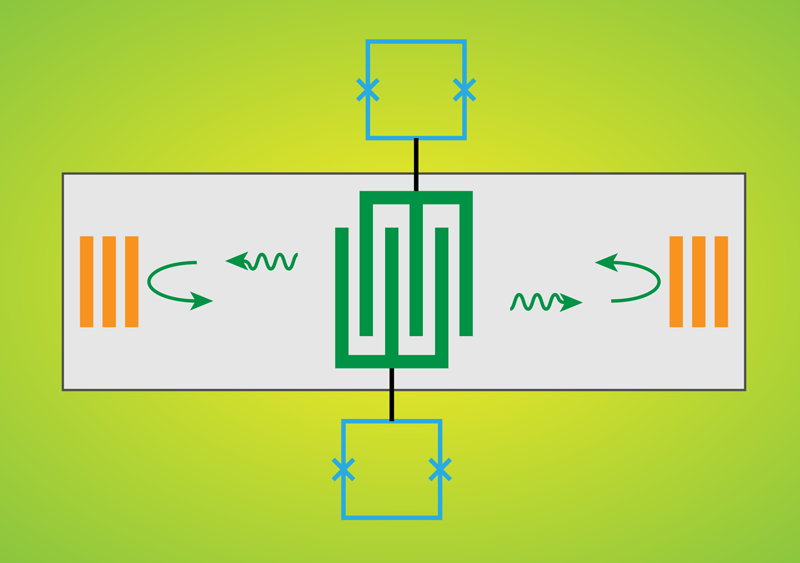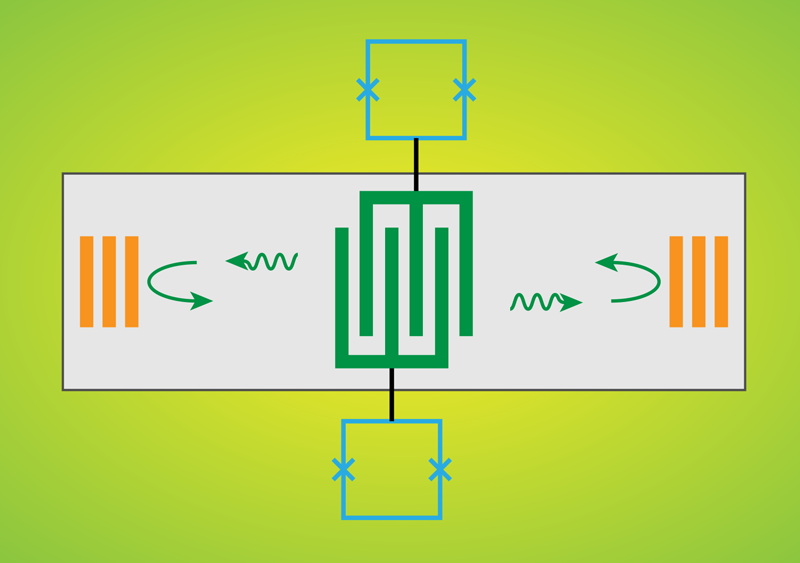Quantum Erasing with Phonons
Few quantum effects are as mind-tripping as the quantum eraser, in which quantum signatures can appear or disappear depending on the future actions of an experimenter. Previous quantum eraser experiments have used photons, but a research team has now demonstrated the same bewildering phenomenon with phonons, the quantum particles of vibration and sound. The ability to perform this magic trick with phonons suggests that the particles might serve as useful intermediaries in the transport of quantum information over long distances.
The quantum eraser was first proposed nearly 40 years ago [1]. The original concept was based on the textbook double-slit experiment, where light entering two narrow slits produces an interference pattern of alternating light and dark stripes on a screen. The eraser scheme involves installing a device that records which slit each photon enters. The measurement destroys the interference, as each photon is forced to behave like a particle, rather than a wave. However, if this “which-path” information is erased (say, by scrambling the data output), the interference returns. Bizarrely, the interference can be restored even when the erasing step is delayed until after each photon has been detected on the screen (see Focus: Another Step Back for Wave-Particle Duality).
The first experimental realization of the quantum eraser used photons in an optical interferometer [2], but any quantum object should work. Andrew Cleland of the University of Chicago and colleagues have now demonstrated quantum erasing with phonons, which travel about 105 times slower than photons. “Phonons give you a much bigger time window to do things and relieve some of the challenges in doing a quantum eraser experiment,” Cleland says.
Cleland and his team can generate single phonons that travel on the surface of a long and narrow slab (or channel) of piezoelectric material connected to two superconducting quantum bits (qubits). Electronic signals from the qubits are converted into phonons in the channel through a tiny comb-shaped device at the channel's center. The phonons reflect off “acoustic mirrors” at the two ends of the channel and then return to the device, where they reconvert back to electronic signals. In recent work, the researchers demonstrated that phonons could transfer quantum information between the two qubits [3].
To demonstrate quantum erasing, the team performed a series of three experiments. The first was a basic interferometer setup, in which one qubit was excited and coupled to the channel. The coupling was such that there was a 50% chance that the qubit would de-excite to its ground state and produce a phonon in the channel. This phonon—called the signal—would reflect off the mirrors and return to the qubit, where it would interfere with the other 50%-chance option, in which the qubit remained excited and no signal phonon was produced. The combination of these two “paths” determined the final state of the qubit. Over multiple runs, the team measured the qubit state and observed an interference pattern for the probability of finding it excited.
The second experiment began with the interferometer but added another “conditional” phonon—called the herald—that travels from the first qubit to the second qubit and excites the second qubit. The herald is only generated if the first qubit is excited, which means that this phonon carries which-path information concerning the signal phonon. Measuring the second qubit’s state resulted in a disappearance of the interference pattern in the first qubit’s readout.
The last experiment was the erasing step. The team applied a microwave pulse to the second qubit that essentially scrambled the information it held. When all the data were compiled, the fringe pattern reappeared in the measurement of the first qubit. Interestingly, the herald takes about 0.5 microseconds to travel through the phonon channel, allowing the first qubit to be fully measured before the herald arrives at the second qubit. This delay means that the choice of erasing (or not erasing) can occur after the quantum information is recorded.
Cleland says the eraser highlights the potential of phonons as quantum information carriers. Photons are the commonly used carriers, but they are difficult to couple to qubits. Cleland’s team is working on interfaces that could translate qubit information into a photon signal by using phonons as an intermediary.
“This experiment has made a considerable leap forward in demonstrating quantum information protocols for phonons, showing that they can be utilized very much like photons in quantum optics setups,” says theoretical physicist Miles Blencowe from Dartmouth University in New Hampshire. He says that the shorter wavelengths of phonons (compared with photons of the same frequency) could enable more compact quantum circuitry.
This research is published in Physical Review X.
–Michael Schirber
Michael Schirber is a Corresponding Editor for Physics Magazine based in Lyon, France.
References
- M. O. Scully and K. Drühl, “Quantum eraser: A proposed photon correlation experiment concerning observation and ‘delayed choice’ in quantum mechanics,” Phys. Rev. A 25, 2208 (1982).
- P. G. Kwiat et al., “Observation of a ‘quantum eraser’: A revival of coherence in a two-photon interference experiment,” Phys. Rev. A 45, 7729 (1992).
- A. Bienfait et al., “Phonon-mediated quantum state transfer and remote qubit entanglement,” Science 364, 368 (2019).





